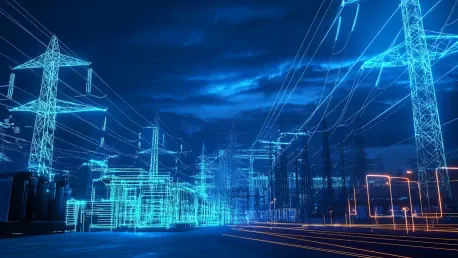Extreme weather patterns driven by climate change are posing increasing challenges for utilities in the United States. These phenomena are causing unpredictable spikes in energy demand that the current infrastructure is struggling to meet. Grid operators are compelled to employ new strategies to handle these fluctuations more efficiently.
The Climate Challenge
Rising Demand and Strain on the Grid
In the past decade, extreme temperature variations have become more frequent and severe due to climate change. These variations result in heightened demand for heating during cold snaps and cooling during heatwaves. This surge in demand puts significant strain on the existing energy infrastructure, calling for a reevaluation of energy management strategies. Traditional power grids, designed for more stable weather patterns, struggle to cope with these sudden spikes and drops in energy usage. This has led to increased blackouts and grid failures, impacting both residential and commercial activities and highlighting the urgent need for more flexible and resilient energy systems.
These climate-induced challenges underscore the importance of transitioning from conventional energy management models to more dynamic and adaptive frameworks. The energy sector must explore innovative solutions that not only meet the immediate demands but also enhance the overall resilience of the grid. A modernized grid infrastructure capable of weathering these environmental stresses is not only essential for maintaining reliable service but also crucial for supporting the broader goals of reducing greenhouse gas emissions and promoting sustainable energy practices.
Virtual Power Plant (VPP) Solution
The primary solution lies in implementing and expanding Virtual Power Plants (VPPs). VPPs are aggregations of distributed energy resources (DERs) including solar panels, battery storage systems, electric vehicles (EVs), and smart devices. These resources can be collectively managed to balance electricity supply and demand, offering the same benefits as traditional power plants without centralized generation. VPPs harness the potential of decentralized energy production and storage, creating a more flexible and adaptive grid that can respond to changing energy needs more effectively. This approach shifts the paradigm from a top-down energy distribution model to a more distributed, bottom-up system.
The inclusion of diverse DERs within VPPs offers not only redundancy but also the ability to optimize energy use based on real-time data and forecasts. For instance, during peak demand periods, stored energy from batteries can be deployed to prevent overloading the grid, while solar panels can provide clean power during daylight hours, reducing reliance on fossil fuels. This integrated approach minimizes energy waste and enhances the overall efficiency of the power grid. The flexibility and adaptability of VPPs make them a vital tool in addressing the dual challenges of increasing energy demands and the need for a more sustainable and resilient power supply infrastructure.
Enhancing VPP Capacity
Current and Required Capacity
The Department of Energy (DOE) reports that the current VPP capacity in the United States ranges between 30-60 GWh. However, this needs to increase significantly to 80-160 GWh to meet future demand and mitigate the effects of extreme weather events. Boosting this capacity involves enhancing demand flexibility programs like demand response and EV managed charging. These programs enable more effective integration of renewable energy sources by balancing supply with demand in real-time. For example, during periods of high solar generation, EVs can be charged to absorb excess energy, while at times of peak demand, the same EVs can discharge energy back to the grid.
Meeting the required VPP capacity also necessitates significant investment in infrastructure and technology. Advanced distributed energy resource management systems (DERMS) play a critical role in coordinating and optimizing the performance of the numerous DERs involved in a VPP. By leveraging sophisticated algorithms and real-time data analytics, DERMS ensure that energy is distributed efficiently and demand is met without overloading the grid. This level of coordination is crucial for maintaining grid stability and reliability, especially as the penetration of variable renewable energy sources like wind and solar continues to grow.
Successful Implementations
Effective deployment of VPPs is already seen in sunny regions like Texas and Puerto Rico, where consistent solar energy output supports decentralized energy resources. These areas demonstrate reduced dependency on traditional power plants and improved peak load management through successful community-generated energy projects. The success in these regions provides a proof-of-concept for other areas looking to implement similar strategies. Localized energy production and management not only improve resilience to extreme weather events but also empower communities by giving them greater control over their energy sources.
One of the standout examples can be found in Puerto Rico, where community-led solar projects have gained traction following the devastating impacts of hurricanes. These projects highlight the viability of decentralized energy systems in enhancing grid resilience. Similarly, in Texas, where weather can swing dramatically, VPPs have proven effective in managing these changes without overburdening the grid. These instances underscore the potential for VPPs to deliver both economic and environmental benefits, serving as a blueprint for other regions facing similar climate challenges. The successes in these areas demonstrate the practical advantages and potential of VPPs in various settings.
Demand Flexibility Programs
Behind-the-Meter Assets
Utilities benefit from VPPs by leveraging behind-the-meter DER assets in residential, business, and commercial settings. Grid-edge distributed energy resource management systems (DERMS) aggregate these varied energy resources for use in demand flexibility programs. This includes initiatives such as thermostat programs to reduce usage during peak periods. Residential solar panels, smart thermostats, and battery storage systems all contribute to these aggregate resources, creating a buffer that utilities can tap into during times of high demand. These resources are key to creating a responsive and adaptable energy grid.
By using behind-the-meter assets, utilities can better manage load distribution, reduce the need for costly infrastructure upgrades, and enhance their ability to meet regulatory requirements for renewable energy use. Commercial settings add another layer of complexity and opportunity. Businesses equipped with DERs can participate in demand response programs, where they receive incentives for reducing energy usage during peak periods. Commercial battery systems and EV fleets can also be managed dynamically to support the grid, showing the extensive potential of DER integration across different sectors.
Customer Engagement
Utilities must prioritize customer enrollment and engagement to run VPPs effectively. Marketing the benefits of VPP programs and conducting market research to identify ideal devices and partners help target strategies, ensuring widespread participation and maximizing available VPP capacity. Effective communication strategies are crucial in highlighting the dual benefits of cost savings and enhanced grid reliability to customers. Engaging customers through educational campaigns can demystify VPP technologies and their benefits, encouraging broader participation and acceptance.
Achieving substantial customer participation also requires understanding consumer behavior and preferences. Market research can pinpoint the most commonly used devices and the most trusted brands within a service territory, allowing utilities to tailor their programs accordingly. Collaboration with device manufacturers and local businesses can further enhance program reach and effectiveness. By fostering a sense of community involvement and demonstrating the tangible benefits of participation, utilities can build a broad and active base of engaged consumers who contribute to the overall success of VPP initiatives.
Advanced Technologies for Optimization
Predictive Analytics and Demand Forecasting
Advanced monitoring and predictive analytics are key factors in optimizing VPP operations. Smart grid technologies provide critical metrics, enabling utilities to accurately plan demand events and energy purchases. Forecasting technology helps predict severe weather patterns, allowing for proactive crew and resource positioning. By combining meteorological data with real-time grid performance metrics, utilities can anticipate demand surges and adjust their operations accordingly. This foresight not only improves reliability but also helps in minimizing outages and ensuring continuous service even during extreme weather events.
Predictive analytics also enable more efficient utilization of distributed energy resources. By analyzing historical usage patterns and current grid conditions, utilities can optimize the dispatch of energy from batteries, solar panels, and other DERs. This dynamic approach ensures that energy is used where it is needed most, reducing waste and enhancing overall grid efficiency. Additionally, predictive maintenance can identify potential issues before they escalate into major problems, reducing downtime and extending the lifespan of critical infrastructure. These advanced technologies are indispensable for modernizing the grid and meeting the growing demands imposed by climate change.
Battery Energy Storage
The significance of battery energy storage within VPPs is also emphasized. Increased U.S. battery storage capacity supports demand flexibility initiatives and energy arbitrage strategies. Batteries manage stored energy effectively, reducing charging speeds or utilizing stored energy during peak times to lower Time of Use (TOU) rates. Efficient energy storage is pivotal in balancing the supply-demand equation, especially when renewable energy sources are part of the mix. Batteries can store excess energy generated during periods of low demand and release it during peak demand, thus smoothing out the fluctuations typical of renewable energy sources.
Battery storage systems also play a crucial role in energy arbitrage, where stored energy is sold back to the grid during high-demand periods at premium rates. This not only provides a financial incentive for energy producers but also helps in stabilizing the grid. Enhanced battery technologies and decreasing costs are making widespread adoption more viable, further boosting the potential of VPPs. Moreover, integrating battery storage with smart management systems enables real-time decision-making, ensuring that energy is dispatched efficiently and economically. These advancements in battery storage technology are critical for the continued growth and effectiveness of VPPs.
Overcoming Reliability Challenges
Managing DER Variability
Reliability of behind-the-meter DER assets remains a challenge due to environmental factors, such as reduced effectiveness of solar panels on cloudy days. However, VPPs offer a solution through aggregate load shifting, which diversifies individual DER performance. By pooling resources across a wide geographic area, VPPs can mitigate the variability of individual DERs. For example, while solar panel efficiency may drop in one region due to cloud cover, other areas with clear skies can compensate, maintaining a balanced energy supply. This collective approach helps in stabilizing the overall output despite localized fluctuations.
Advanced tools like Topline Demand Control, which combine predictive control, AI, and DERMS, are designed to optimize DER performance. These tools analyze vast amounts of data to predict energy generation and consumption patterns accurately, enabling utilities to make informed decisions about load distribution and energy dispatch. By leveraging these sophisticated systems, grid operators can ensure a more stable and reliable energy supply, reducing the impact of environmental variability on individual DERs. These technologies are key in overcoming the inherent uncertainties associated with renewable energy sources and enhancing the robustness of VPPs.
Ensuring Reliable Output
Extreme weather patterns, increasingly driven by climate change, are presenting mounting challenges for utilities across the United States. These weather anomalies lead to unpredictable surges in energy demand, which the existing infrastructure is finding hard to accommodate. Sudden heatwaves, intense storms, and prolonged droughts, among other climatic events, are contributing to these erratic energy needs. As a result, grid operators are compelled to develop and implement innovative strategies to manage these fluctuations more effectively. They are investing in advanced technologies, such as smart grids and real-time monitoring systems, to enhance the grid’s resilience and responsiveness. Furthermore, utilities are exploring renewable energy sources like solar and wind power to diversify and stabilize the energy supply. By integrating these renewable resources, they not only aim to meet demand spikes but also reduce the overall environmental impact of energy production. It’s an ongoing challenge that requires a multifaceted approach, encompassing technological advancements, policy changes, and increased collaboration between various stakeholders in the energy sector.









